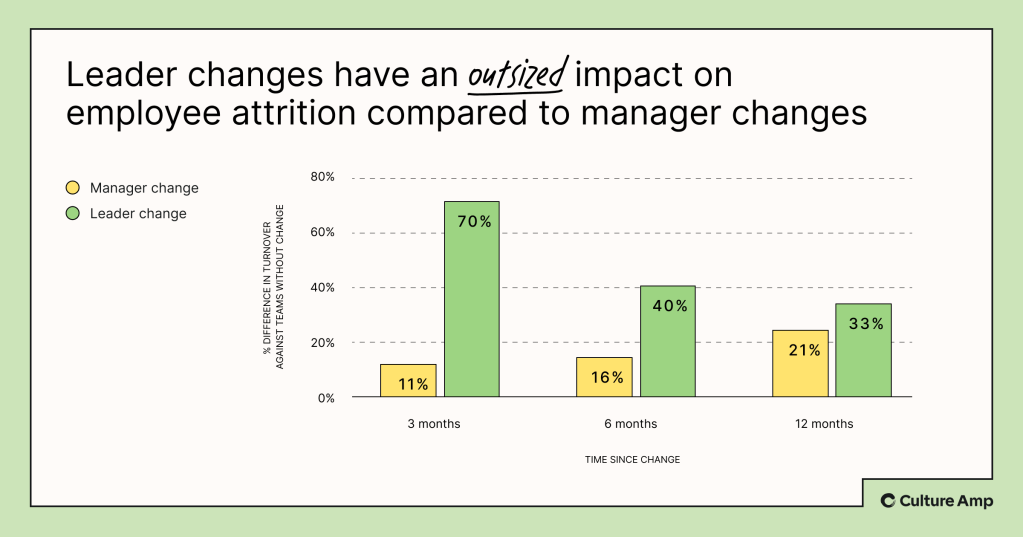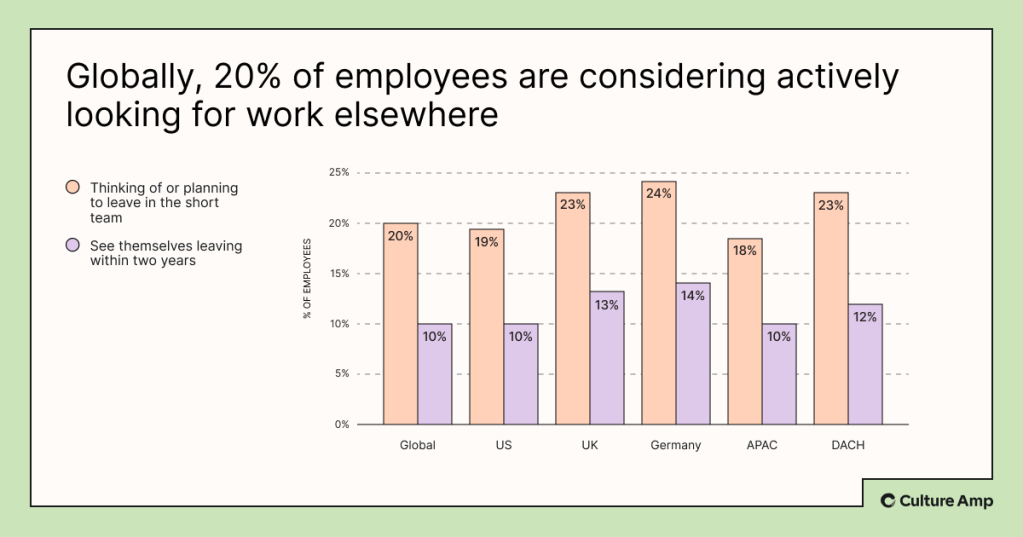When great people leave, businesses take a hit. The cost to replace an employee can be anywhere from 30% to 200% of their salary according to our Culture Amp data, and competition for the best talent is fierce in a tight market.

If your organisation was on fire and you had to save just one thing from the burning building, what would it be? The people of course. Your people are the lifeblood of your organisation, their knowledge, connections, expertise and creativity are what sets up any company for success.
So when great people leave, businesses take a hit. The cost to replace an employee can be anywhere from 30% to 200% of their salary according to our Culture Amp data, and competition for the best talent is fierce in a tight market.
For a long time, we’ve believed the quality of leadership plays a defining role in the success of any organisation, and recent data we’ve gathered globally underscores the outsized impact of leadership. While managers influence day-to-day employee experiences, it is the broader impact of leadership on trust, engagement, and culture, which determines whether teams stay intact or drift away.
A global shift
Globally, 20% of employees are actively searching for new opportunities, a 2% rise from the previous year. In APAC, we’ve observed similar trends, though the dynamics vary across countries. For example, industries experiencing rapid technological shifts or economic uncertainty often see higher attrition rates, cementing the critical role of leadership in stabilising teams.

Leadership transitions are especially disruptive. Our research shows that teams affected by leadership changes face a 40% increase in attrition within six months, compared to those with consistent leadership. For us in APAC, this disruption is amplified by the region’s diverse workforce and varying expectations of leadership styles.
Leadership and loyalty
Our data highlights how profoundly leadership affects employee commitment. Under a good manager and a great leader, employee commitment to stay is at its highest point – 94%. However, with a poor leader, even good managers see the commitment of their people to stay dropping to 35%.
Leadership transitions can lead to a 70% spike in attrition within the first three months, with the ‘follow the leader’ effect meaning many employees will follow a trusted leader to new opportunities. Employees are more likely to align their loyalty with a leader who shares their values and vision, so when leaders leave, they frequently take top talent with them.


Breaking the bad manager myth
The idea that employees leave managers, not companies has long influenced retention strategies. However, our findings suggest that leadership, rather than individual managers, is actually the decisive factor.
In surveying people who’ve decided to leave an organisation, those citing manager (12%) and pay (11%) was roughly the same, but those citing leadership as their reason for leaving was more than double that, at 28%.
“Retention matters and quality leadership should be the aim of every leader in your organisation.”
Andy Brockhoff, Culture Amp
As with anything in business, retention is not a set-and-forget process – it requires consistent care, the right environment, and strong leadership. However, the reality is, leaders will leave. People will seek new opportunities and the make-up of your teams will evolve over time.
But you can proactively defend against the retention impact of leaders who leave, or low-quality leadership. Ideally, you need your managers and your leaders to align so that they’re sharing the same message and setting the same expectations internally.
Transparency and trust
In a time of leadership change, clear communication is essential for building trust and reducing uncertainty. Having a clear succession plan for leadership and preparing future leaders ahead of time can also make for smoother transitions.
Employee engagement is directly linked to employee retention, and in previous surveys we’ve found that leadership is the highest driver of employee engagement globally. Of the most engaged employees, 78% agreed or strongly agreed with the statement: “I have confidence in the leaders at [Company].”

So outside of leadership transition times, aim to build a culture where people understand the company values and see these embodied by the senior leadership team to strengthen employee loyalty.
Actions really do speak louder than words when it comes to leadership, so encourage leaders to align their actions and priorities with the company values and overarching mission.
Because retention matters and quality leadership should be the aim of every leader in your organisation.
Andy Brockhoff is General Manager & Vice President of Asia-Pacific at Culture Amp.
Forbes Women is mobilising a network of female business owners, entrepreneurs and changemakers who support and empower each other. Become a member here.


